International Trade Report: UK-China Banking Industry and Trade
VerifiedAdded on 2023/01/16
|12
|3989
|37
Report
AI Summary
This report provides an in-depth analysis of international trade, focusing on the banking industry and the economic relationship between the UK and China. It begins with an introduction to international trade and its significance, followed by an examination of economies of scale, differentiating between external and internal economies and their impact on the banking sector. The report then delves into intra-industry trade, particularly between the UK and China, highlighting the role of Brexit and the increasing investment of China in the UK's banking sector. It explores strategies for expanding trade, such as collaboration and fair competition. Furthermore, the report investigates the role of innovation and research and development expenditure in export growth, emphasizing the impact of innovation on the finance industry and the importance of research and development investment. The report concludes with a discussion of whether the Eurozone is an optimum currency area, though the provided text does not give a conclusion about it, and references supporting the analysis.
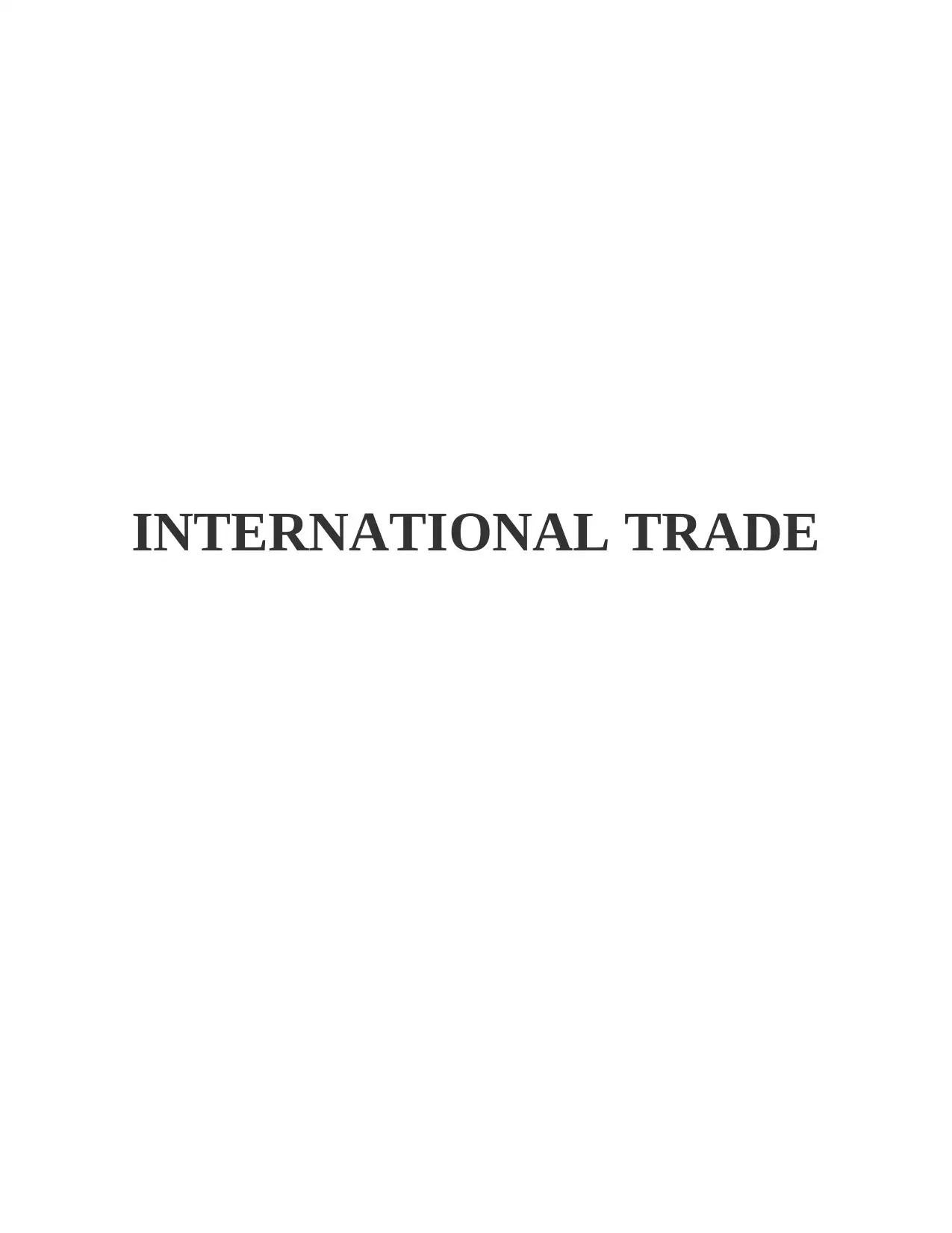
INTERNATIONAL TRADE
Paraphrase This Document
Need a fresh take? Get an instant paraphrase of this document with our AI Paraphraser
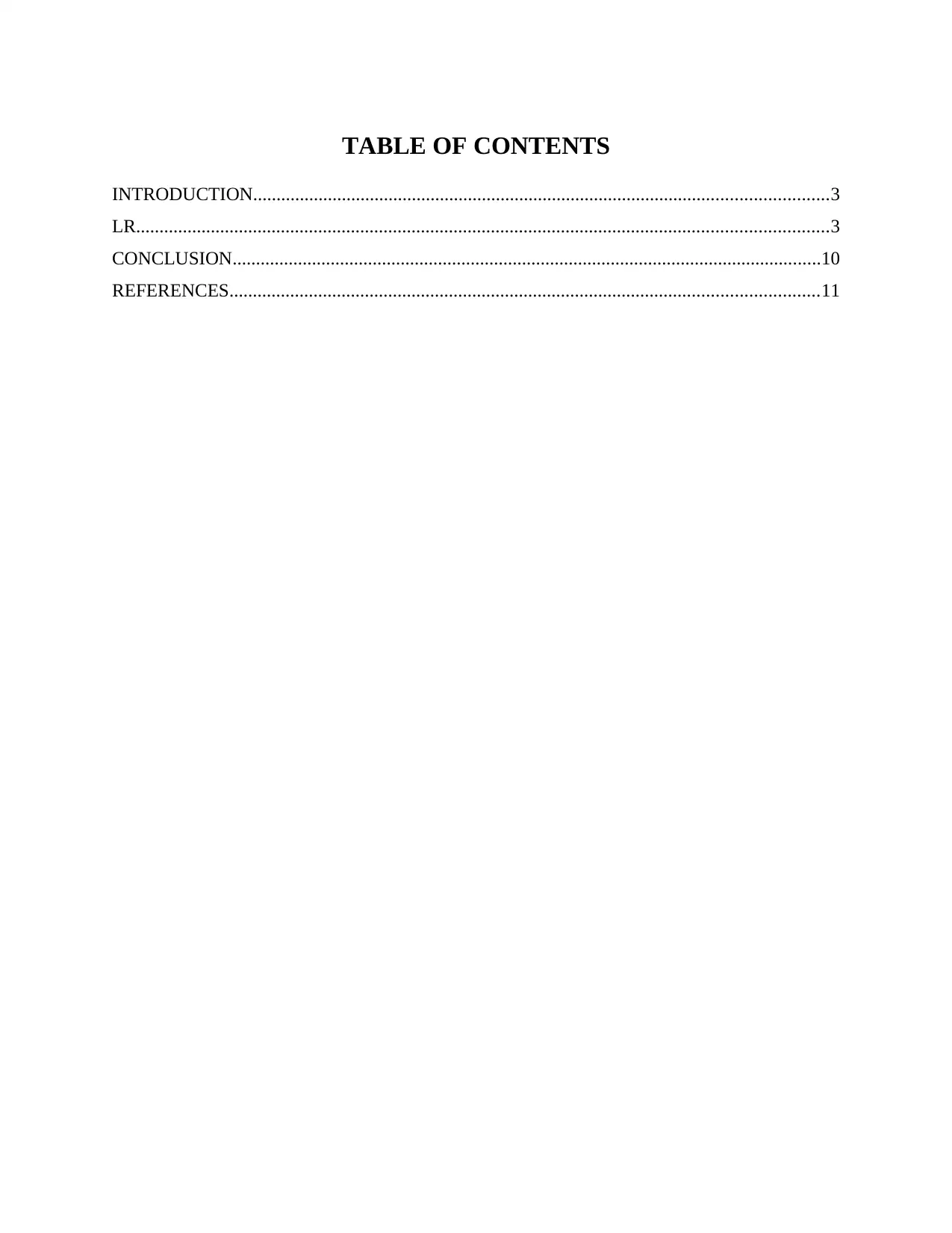
TABLE OF CONTENTS
INTRODUCTION...........................................................................................................................3
LR....................................................................................................................................................3
CONCLUSION..............................................................................................................................10
REFERENCES..............................................................................................................................11
INTRODUCTION...........................................................................................................................3
LR....................................................................................................................................................3
CONCLUSION..............................................................................................................................10
REFERENCES..............................................................................................................................11
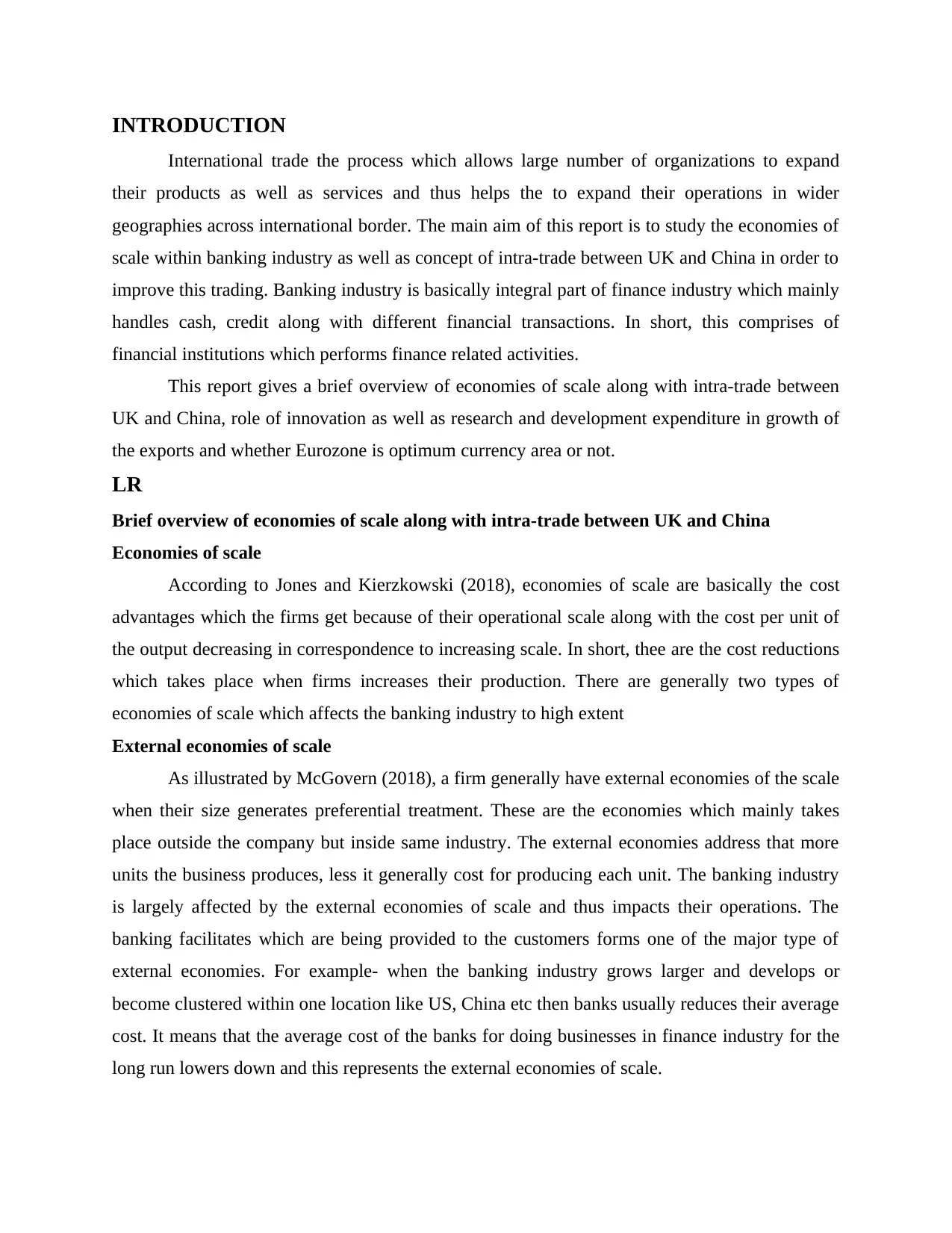
INTRODUCTION
International trade the process which allows large number of organizations to expand
their products as well as services and thus helps the to expand their operations in wider
geographies across international border. The main aim of this report is to study the economies of
scale within banking industry as well as concept of intra-trade between UK and China in order to
improve this trading. Banking industry is basically integral part of finance industry which mainly
handles cash, credit along with different financial transactions. In short, this comprises of
financial institutions which performs finance related activities.
This report gives a brief overview of economies of scale along with intra-trade between
UK and China, role of innovation as well as research and development expenditure in growth of
the exports and whether Eurozone is optimum currency area or not.
LR
Brief overview of economies of scale along with intra-trade between UK and China
Economies of scale
According to Jones and Kierzkowski (2018), economies of scale are basically the cost
advantages which the firms get because of their operational scale along with the cost per unit of
the output decreasing in correspondence to increasing scale. In short, thee are the cost reductions
which takes place when firms increases their production. There are generally two types of
economies of scale which affects the banking industry to high extent
External economies of scale
As illustrated by McGovern (2018), a firm generally have external economies of the scale
when their size generates preferential treatment. These are the economies which mainly takes
place outside the company but inside same industry. The external economies address that more
units the business produces, less it generally cost for producing each unit. The banking industry
is largely affected by the external economies of scale and thus impacts their operations. The
banking facilitates which are being provided to the customers forms one of the major type of
external economies. For example- when the banking industry grows larger and develops or
become clustered within one location like US, China etc then banks usually reduces their average
cost. It means that the average cost of the banks for doing businesses in finance industry for the
long run lowers down and this represents the external economies of scale.
International trade the process which allows large number of organizations to expand
their products as well as services and thus helps the to expand their operations in wider
geographies across international border. The main aim of this report is to study the economies of
scale within banking industry as well as concept of intra-trade between UK and China in order to
improve this trading. Banking industry is basically integral part of finance industry which mainly
handles cash, credit along with different financial transactions. In short, this comprises of
financial institutions which performs finance related activities.
This report gives a brief overview of economies of scale along with intra-trade between
UK and China, role of innovation as well as research and development expenditure in growth of
the exports and whether Eurozone is optimum currency area or not.
LR
Brief overview of economies of scale along with intra-trade between UK and China
Economies of scale
According to Jones and Kierzkowski (2018), economies of scale are basically the cost
advantages which the firms get because of their operational scale along with the cost per unit of
the output decreasing in correspondence to increasing scale. In short, thee are the cost reductions
which takes place when firms increases their production. There are generally two types of
economies of scale which affects the banking industry to high extent
External economies of scale
As illustrated by McGovern (2018), a firm generally have external economies of the scale
when their size generates preferential treatment. These are the economies which mainly takes
place outside the company but inside same industry. The external economies address that more
units the business produces, less it generally cost for producing each unit. The banking industry
is largely affected by the external economies of scale and thus impacts their operations. The
banking facilitates which are being provided to the customers forms one of the major type of
external economies. For example- when the banking industry grows larger and develops or
become clustered within one location like US, China etc then banks usually reduces their average
cost. It means that the average cost of the banks for doing businesses in finance industry for the
long run lowers down and this represents the external economies of scale.
⊘ This is a preview!⊘
Do you want full access?
Subscribe today to unlock all pages.

Trusted by 1+ million students worldwide
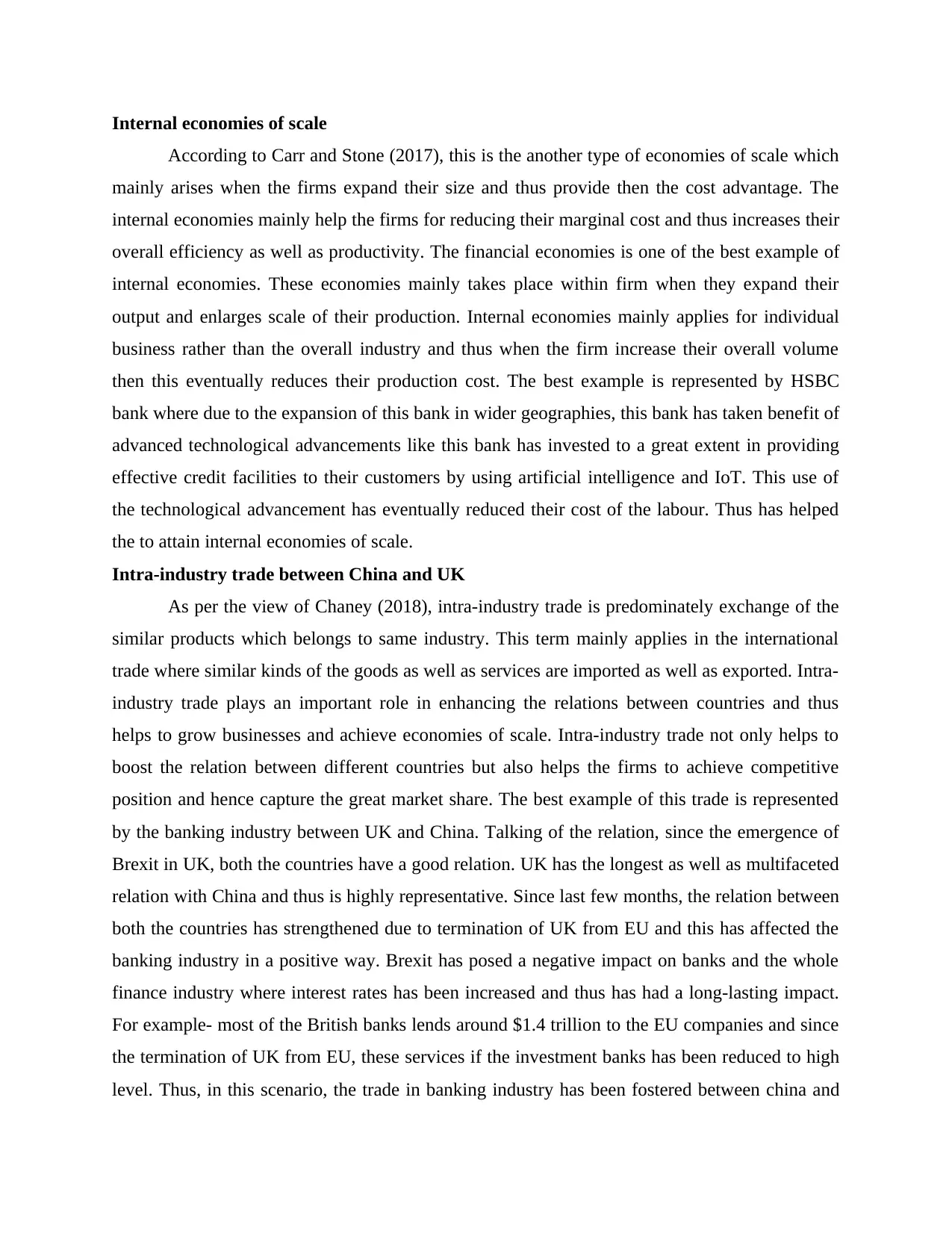
Internal economies of scale
According to Carr and Stone (2017), this is the another type of economies of scale which
mainly arises when the firms expand their size and thus provide then the cost advantage. The
internal economies mainly help the firms for reducing their marginal cost and thus increases their
overall efficiency as well as productivity. The financial economies is one of the best example of
internal economies. These economies mainly takes place within firm when they expand their
output and enlarges scale of their production. Internal economies mainly applies for individual
business rather than the overall industry and thus when the firm increase their overall volume
then this eventually reduces their production cost. The best example is represented by HSBC
bank where due to the expansion of this bank in wider geographies, this bank has taken benefit of
advanced technological advancements like this bank has invested to a great extent in providing
effective credit facilities to their customers by using artificial intelligence and IoT. This use of
the technological advancement has eventually reduced their cost of the labour. Thus has helped
the to attain internal economies of scale.
Intra-industry trade between China and UK
As per the view of Chaney (2018), intra-industry trade is predominately exchange of the
similar products which belongs to same industry. This term mainly applies in the international
trade where similar kinds of the goods as well as services are imported as well as exported. Intra-
industry trade plays an important role in enhancing the relations between countries and thus
helps to grow businesses and achieve economies of scale. Intra-industry trade not only helps to
boost the relation between different countries but also helps the firms to achieve competitive
position and hence capture the great market share. The best example of this trade is represented
by the banking industry between UK and China. Talking of the relation, since the emergence of
Brexit in UK, both the countries have a good relation. UK has the longest as well as multifaceted
relation with China and thus is highly representative. Since last few months, the relation between
both the countries has strengthened due to termination of UK from EU and this has affected the
banking industry in a positive way. Brexit has posed a negative impact on banks and the whole
finance industry where interest rates has been increased and thus has had a long-lasting impact.
For example- most of the British banks lends around $1.4 trillion to the EU companies and since
the termination of UK from EU, these services if the investment banks has been reduced to high
level. Thus, in this scenario, the trade in banking industry has been fostered between china and
According to Carr and Stone (2017), this is the another type of economies of scale which
mainly arises when the firms expand their size and thus provide then the cost advantage. The
internal economies mainly help the firms for reducing their marginal cost and thus increases their
overall efficiency as well as productivity. The financial economies is one of the best example of
internal economies. These economies mainly takes place within firm when they expand their
output and enlarges scale of their production. Internal economies mainly applies for individual
business rather than the overall industry and thus when the firm increase their overall volume
then this eventually reduces their production cost. The best example is represented by HSBC
bank where due to the expansion of this bank in wider geographies, this bank has taken benefit of
advanced technological advancements like this bank has invested to a great extent in providing
effective credit facilities to their customers by using artificial intelligence and IoT. This use of
the technological advancement has eventually reduced their cost of the labour. Thus has helped
the to attain internal economies of scale.
Intra-industry trade between China and UK
As per the view of Chaney (2018), intra-industry trade is predominately exchange of the
similar products which belongs to same industry. This term mainly applies in the international
trade where similar kinds of the goods as well as services are imported as well as exported. Intra-
industry trade plays an important role in enhancing the relations between countries and thus
helps to grow businesses and achieve economies of scale. Intra-industry trade not only helps to
boost the relation between different countries but also helps the firms to achieve competitive
position and hence capture the great market share. The best example of this trade is represented
by the banking industry between UK and China. Talking of the relation, since the emergence of
Brexit in UK, both the countries have a good relation. UK has the longest as well as multifaceted
relation with China and thus is highly representative. Since last few months, the relation between
both the countries has strengthened due to termination of UK from EU and this has affected the
banking industry in a positive way. Brexit has posed a negative impact on banks and the whole
finance industry where interest rates has been increased and thus has had a long-lasting impact.
For example- most of the British banks lends around $1.4 trillion to the EU companies and since
the termination of UK from EU, these services if the investment banks has been reduced to high
level. Thus, in this scenario, the trade in banking industry has been fostered between china and
Paraphrase This Document
Need a fresh take? Get an instant paraphrase of this document with our AI Paraphraser
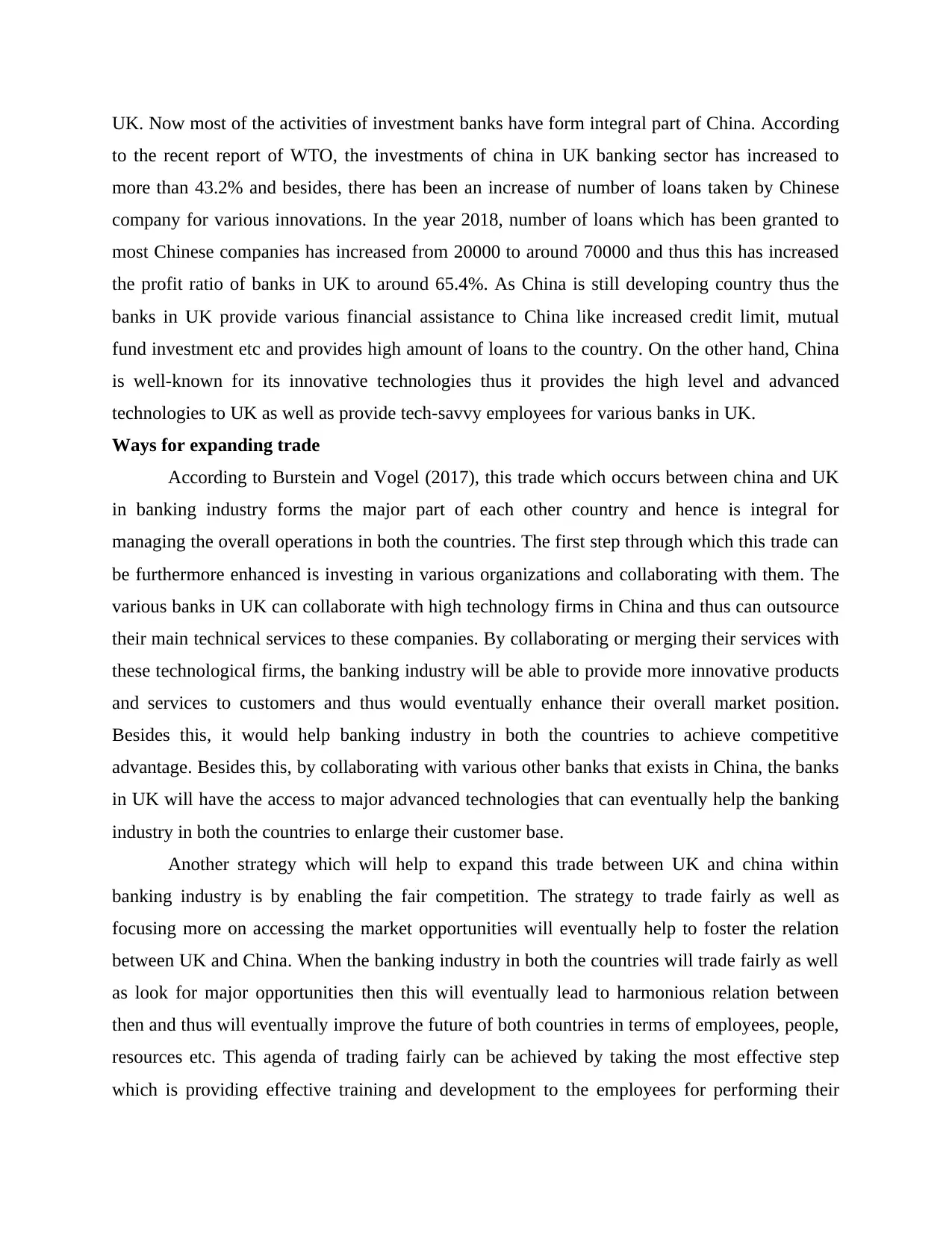
UK. Now most of the activities of investment banks have form integral part of China. According
to the recent report of WTO, the investments of china in UK banking sector has increased to
more than 43.2% and besides, there has been an increase of number of loans taken by Chinese
company for various innovations. In the year 2018, number of loans which has been granted to
most Chinese companies has increased from 20000 to around 70000 and thus this has increased
the profit ratio of banks in UK to around 65.4%. As China is still developing country thus the
banks in UK provide various financial assistance to China like increased credit limit, mutual
fund investment etc and provides high amount of loans to the country. On the other hand, China
is well-known for its innovative technologies thus it provides the high level and advanced
technologies to UK as well as provide tech-savvy employees for various banks in UK.
Ways for expanding trade
According to Burstein and Vogel (2017), this trade which occurs between china and UK
in banking industry forms the major part of each other country and hence is integral for
managing the overall operations in both the countries. The first step through which this trade can
be furthermore enhanced is investing in various organizations and collaborating with them. The
various banks in UK can collaborate with high technology firms in China and thus can outsource
their main technical services to these companies. By collaborating or merging their services with
these technological firms, the banking industry will be able to provide more innovative products
and services to customers and thus would eventually enhance their overall market position.
Besides this, it would help banking industry in both the countries to achieve competitive
advantage. Besides this, by collaborating with various other banks that exists in China, the banks
in UK will have the access to major advanced technologies that can eventually help the banking
industry in both the countries to enlarge their customer base.
Another strategy which will help to expand this trade between UK and china within
banking industry is by enabling the fair competition. The strategy to trade fairly as well as
focusing more on accessing the market opportunities will eventually help to foster the relation
between UK and China. When the banking industry in both the countries will trade fairly as well
as look for major opportunities then this will eventually lead to harmonious relation between
then and thus will eventually improve the future of both countries in terms of employees, people,
resources etc. This agenda of trading fairly can be achieved by taking the most effective step
which is providing effective training and development to the employees for performing their
to the recent report of WTO, the investments of china in UK banking sector has increased to
more than 43.2% and besides, there has been an increase of number of loans taken by Chinese
company for various innovations. In the year 2018, number of loans which has been granted to
most Chinese companies has increased from 20000 to around 70000 and thus this has increased
the profit ratio of banks in UK to around 65.4%. As China is still developing country thus the
banks in UK provide various financial assistance to China like increased credit limit, mutual
fund investment etc and provides high amount of loans to the country. On the other hand, China
is well-known for its innovative technologies thus it provides the high level and advanced
technologies to UK as well as provide tech-savvy employees for various banks in UK.
Ways for expanding trade
According to Burstein and Vogel (2017), this trade which occurs between china and UK
in banking industry forms the major part of each other country and hence is integral for
managing the overall operations in both the countries. The first step through which this trade can
be furthermore enhanced is investing in various organizations and collaborating with them. The
various banks in UK can collaborate with high technology firms in China and thus can outsource
their main technical services to these companies. By collaborating or merging their services with
these technological firms, the banking industry will be able to provide more innovative products
and services to customers and thus would eventually enhance their overall market position.
Besides this, it would help banking industry in both the countries to achieve competitive
advantage. Besides this, by collaborating with various other banks that exists in China, the banks
in UK will have the access to major advanced technologies that can eventually help the banking
industry in both the countries to enlarge their customer base.
Another strategy which will help to expand this trade between UK and china within
banking industry is by enabling the fair competition. The strategy to trade fairly as well as
focusing more on accessing the market opportunities will eventually help to foster the relation
between UK and China. When the banking industry in both the countries will trade fairly as well
as look for major opportunities then this will eventually lead to harmonious relation between
then and thus will eventually improve the future of both countries in terms of employees, people,
resources etc. This agenda of trading fairly can be achieved by taking the most effective step
which is providing effective training and development to the employees for performing their
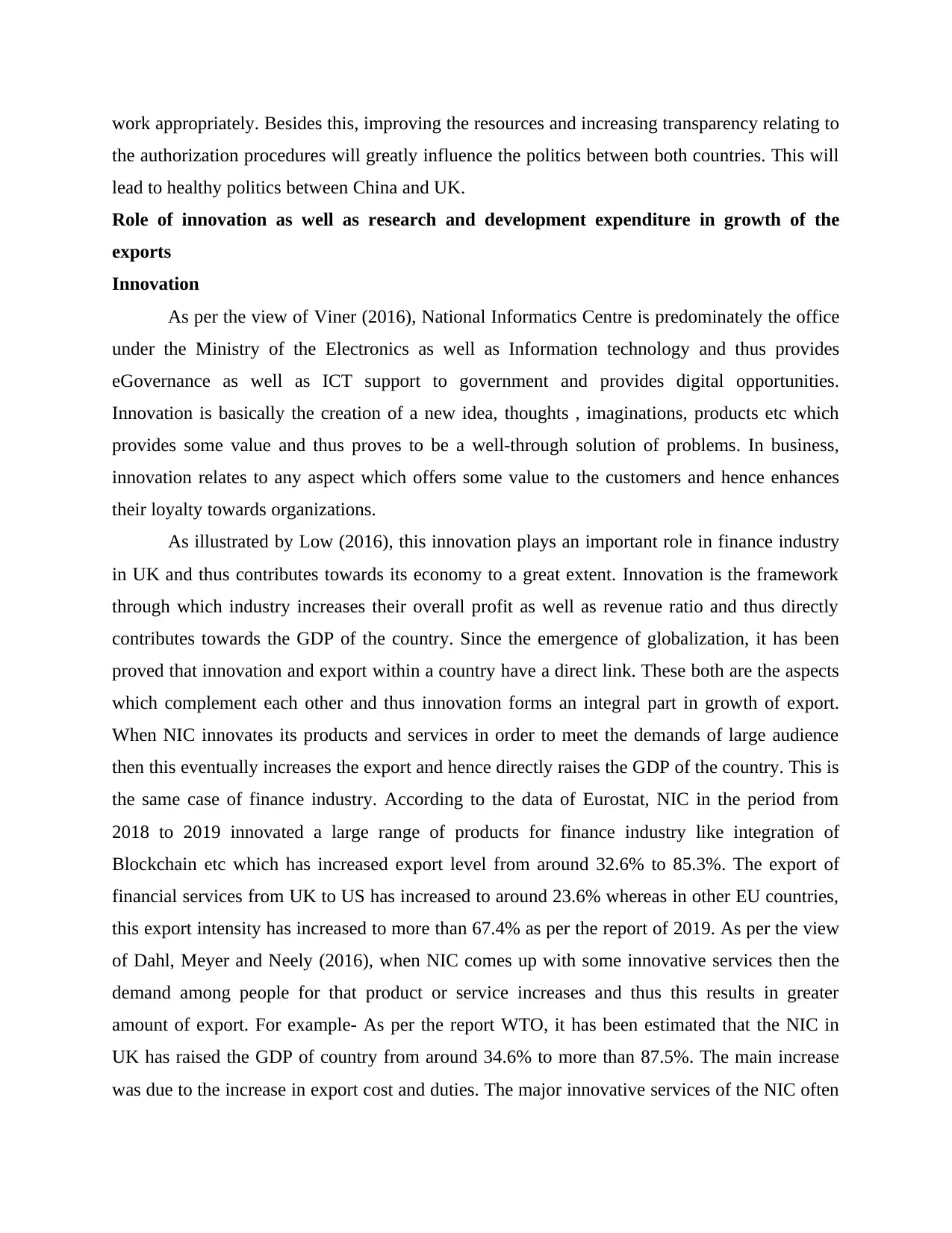
work appropriately. Besides this, improving the resources and increasing transparency relating to
the authorization procedures will greatly influence the politics between both countries. This will
lead to healthy politics between China and UK.
Role of innovation as well as research and development expenditure in growth of the
exports
Innovation
As per the view of Viner (2016), National Informatics Centre is predominately the office
under the Ministry of the Electronics as well as Information technology and thus provides
eGovernance as well as ICT support to government and provides digital opportunities.
Innovation is basically the creation of a new idea, thoughts , imaginations, products etc which
provides some value and thus proves to be a well-through solution of problems. In business,
innovation relates to any aspect which offers some value to the customers and hence enhances
their loyalty towards organizations.
As illustrated by Low (2016), this innovation plays an important role in finance industry
in UK and thus contributes towards its economy to a great extent. Innovation is the framework
through which industry increases their overall profit as well as revenue ratio and thus directly
contributes towards the GDP of the country. Since the emergence of globalization, it has been
proved that innovation and export within a country have a direct link. These both are the aspects
which complement each other and thus innovation forms an integral part in growth of export.
When NIC innovates its products and services in order to meet the demands of large audience
then this eventually increases the export and hence directly raises the GDP of the country. This is
the same case of finance industry. According to the data of Eurostat, NIC in the period from
2018 to 2019 innovated a large range of products for finance industry like integration of
Blockchain etc which has increased export level from around 32.6% to 85.3%. The export of
financial services from UK to US has increased to around 23.6% whereas in other EU countries,
this export intensity has increased to more than 67.4% as per the report of 2019. As per the view
of Dahl, Meyer and Neely (2016), when NIC comes up with some innovative services then the
demand among people for that product or service increases and thus this results in greater
amount of export. For example- As per the report WTO, it has been estimated that the NIC in
UK has raised the GDP of country from around 34.6% to more than 87.5%. The main increase
was due to the increase in export cost and duties. The major innovative services of the NIC often
the authorization procedures will greatly influence the politics between both countries. This will
lead to healthy politics between China and UK.
Role of innovation as well as research and development expenditure in growth of the
exports
Innovation
As per the view of Viner (2016), National Informatics Centre is predominately the office
under the Ministry of the Electronics as well as Information technology and thus provides
eGovernance as well as ICT support to government and provides digital opportunities.
Innovation is basically the creation of a new idea, thoughts , imaginations, products etc which
provides some value and thus proves to be a well-through solution of problems. In business,
innovation relates to any aspect which offers some value to the customers and hence enhances
their loyalty towards organizations.
As illustrated by Low (2016), this innovation plays an important role in finance industry
in UK and thus contributes towards its economy to a great extent. Innovation is the framework
through which industry increases their overall profit as well as revenue ratio and thus directly
contributes towards the GDP of the country. Since the emergence of globalization, it has been
proved that innovation and export within a country have a direct link. These both are the aspects
which complement each other and thus innovation forms an integral part in growth of export.
When NIC innovates its products and services in order to meet the demands of large audience
then this eventually increases the export and hence directly raises the GDP of the country. This is
the same case of finance industry. According to the data of Eurostat, NIC in the period from
2018 to 2019 innovated a large range of products for finance industry like integration of
Blockchain etc which has increased export level from around 32.6% to 85.3%. The export of
financial services from UK to US has increased to around 23.6% whereas in other EU countries,
this export intensity has increased to more than 67.4% as per the report of 2019. As per the view
of Dahl, Meyer and Neely (2016), when NIC comes up with some innovative services then the
demand among people for that product or service increases and thus this results in greater
amount of export. For example- As per the report WTO, it has been estimated that the NIC in
UK has raised the GDP of country from around 34.6% to more than 87.5%. The main increase
was due to the increase in export cost and duties. The major innovative services of the NIC often
⊘ This is a preview!⊘
Do you want full access?
Subscribe today to unlock all pages.

Trusted by 1+ million students worldwide
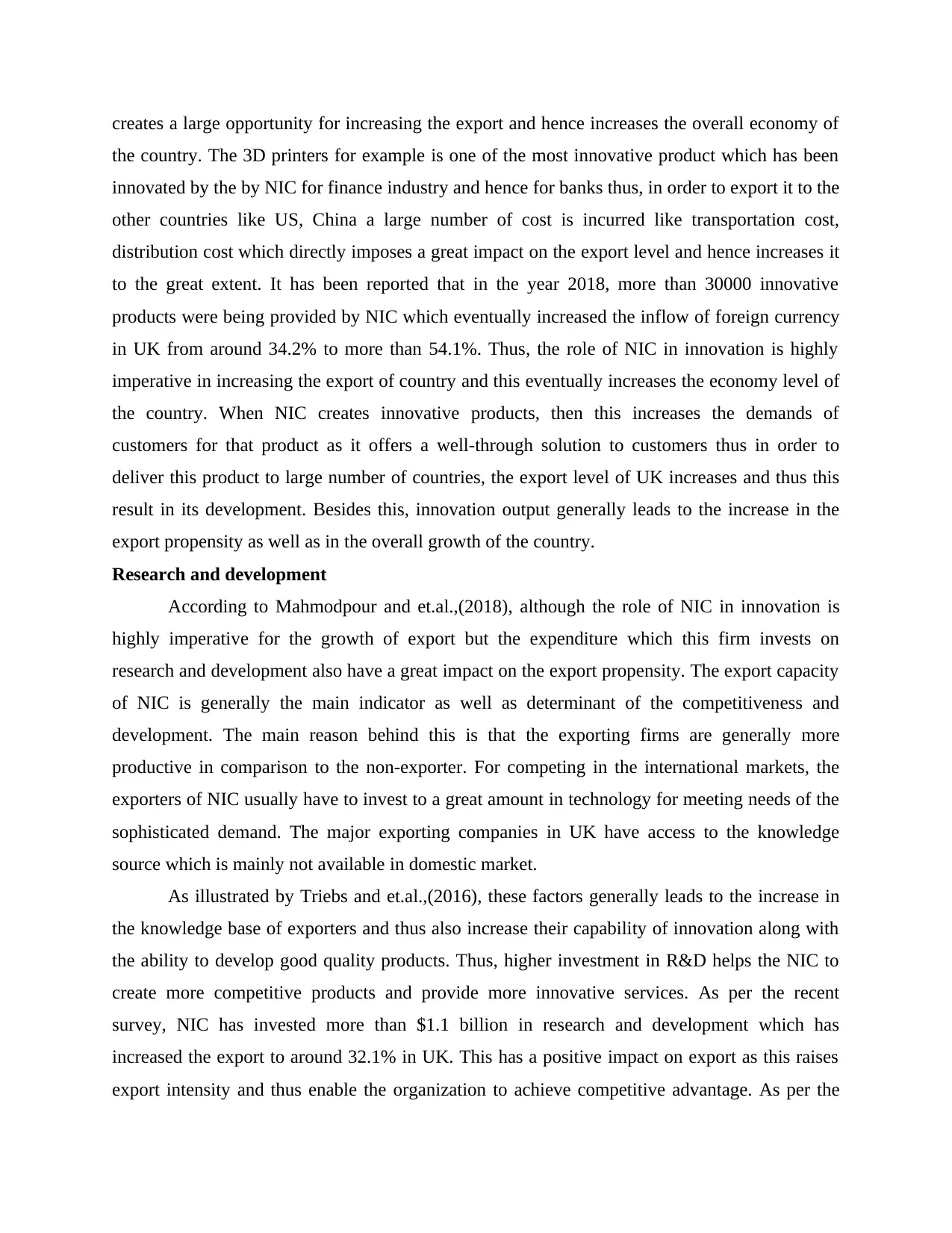
creates a large opportunity for increasing the export and hence increases the overall economy of
the country. The 3D printers for example is one of the most innovative product which has been
innovated by the by NIC for finance industry and hence for banks thus, in order to export it to the
other countries like US, China a large number of cost is incurred like transportation cost,
distribution cost which directly imposes a great impact on the export level and hence increases it
to the great extent. It has been reported that in the year 2018, more than 30000 innovative
products were being provided by NIC which eventually increased the inflow of foreign currency
in UK from around 34.2% to more than 54.1%. Thus, the role of NIC in innovation is highly
imperative in increasing the export of country and this eventually increases the economy level of
the country. When NIC creates innovative products, then this increases the demands of
customers for that product as it offers a well-through solution to customers thus in order to
deliver this product to large number of countries, the export level of UK increases and thus this
result in its development. Besides this, innovation output generally leads to the increase in the
export propensity as well as in the overall growth of the country.
Research and development
According to Mahmodpour and et.al.,(2018), although the role of NIC in innovation is
highly imperative for the growth of export but the expenditure which this firm invests on
research and development also have a great impact on the export propensity. The export capacity
of NIC is generally the main indicator as well as determinant of the competitiveness and
development. The main reason behind this is that the exporting firms are generally more
productive in comparison to the non-exporter. For competing in the international markets, the
exporters of NIC usually have to invest to a great amount in technology for meeting needs of the
sophisticated demand. The major exporting companies in UK have access to the knowledge
source which is mainly not available in domestic market.
As illustrated by Triebs and et.al.,(2016), these factors generally leads to the increase in
the knowledge base of exporters and thus also increase their capability of innovation along with
the ability to develop good quality products. Thus, higher investment in R&D helps the NIC to
create more competitive products and provide more innovative services. As per the recent
survey, NIC has invested more than $1.1 billion in research and development which has
increased the export to around 32.1% in UK. This has a positive impact on export as this raises
export intensity and thus enable the organization to achieve competitive advantage. As per the
the country. The 3D printers for example is one of the most innovative product which has been
innovated by the by NIC for finance industry and hence for banks thus, in order to export it to the
other countries like US, China a large number of cost is incurred like transportation cost,
distribution cost which directly imposes a great impact on the export level and hence increases it
to the great extent. It has been reported that in the year 2018, more than 30000 innovative
products were being provided by NIC which eventually increased the inflow of foreign currency
in UK from around 34.2% to more than 54.1%. Thus, the role of NIC in innovation is highly
imperative in increasing the export of country and this eventually increases the economy level of
the country. When NIC creates innovative products, then this increases the demands of
customers for that product as it offers a well-through solution to customers thus in order to
deliver this product to large number of countries, the export level of UK increases and thus this
result in its development. Besides this, innovation output generally leads to the increase in the
export propensity as well as in the overall growth of the country.
Research and development
According to Mahmodpour and et.al.,(2018), although the role of NIC in innovation is
highly imperative for the growth of export but the expenditure which this firm invests on
research and development also have a great impact on the export propensity. The export capacity
of NIC is generally the main indicator as well as determinant of the competitiveness and
development. The main reason behind this is that the exporting firms are generally more
productive in comparison to the non-exporter. For competing in the international markets, the
exporters of NIC usually have to invest to a great amount in technology for meeting needs of the
sophisticated demand. The major exporting companies in UK have access to the knowledge
source which is mainly not available in domestic market.
As illustrated by Triebs and et.al.,(2016), these factors generally leads to the increase in
the knowledge base of exporters and thus also increase their capability of innovation along with
the ability to develop good quality products. Thus, higher investment in R&D helps the NIC to
create more competitive products and provide more innovative services. As per the recent
survey, NIC has invested more than $1.1 billion in research and development which has
increased the export to around 32.1% in UK. This has a positive impact on export as this raises
export intensity and thus enable the organization to achieve competitive advantage. As per the
Paraphrase This Document
Need a fresh take? Get an instant paraphrase of this document with our AI Paraphraser
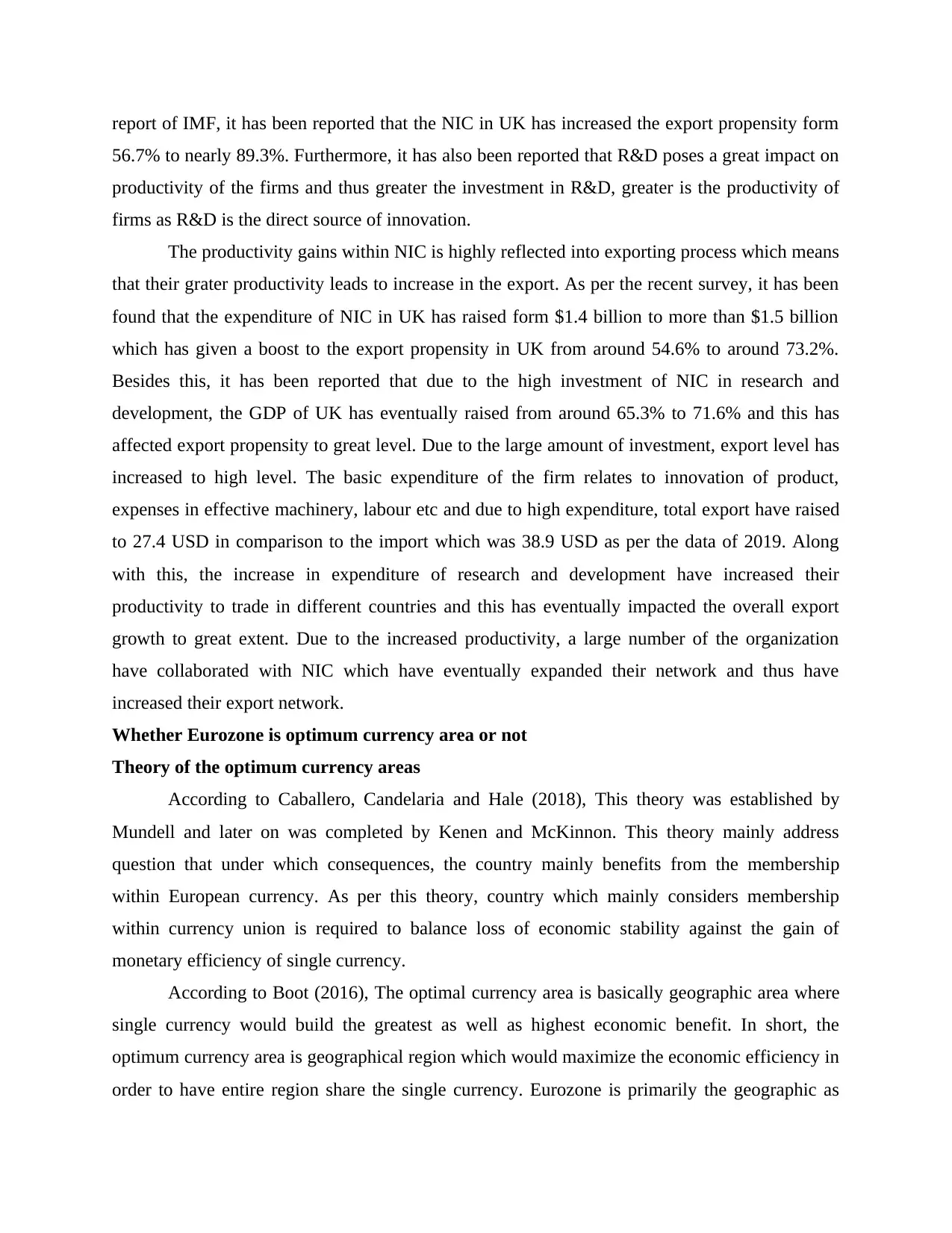
report of IMF, it has been reported that the NIC in UK has increased the export propensity form
56.7% to nearly 89.3%. Furthermore, it has also been reported that R&D poses a great impact on
productivity of the firms and thus greater the investment in R&D, greater is the productivity of
firms as R&D is the direct source of innovation.
The productivity gains within NIC is highly reflected into exporting process which means
that their grater productivity leads to increase in the export. As per the recent survey, it has been
found that the expenditure of NIC in UK has raised form $1.4 billion to more than $1.5 billion
which has given a boost to the export propensity in UK from around 54.6% to around 73.2%.
Besides this, it has been reported that due to the high investment of NIC in research and
development, the GDP of UK has eventually raised from around 65.3% to 71.6% and this has
affected export propensity to great level. Due to the large amount of investment, export level has
increased to high level. The basic expenditure of the firm relates to innovation of product,
expenses in effective machinery, labour etc and due to high expenditure, total export have raised
to 27.4 USD in comparison to the import which was 38.9 USD as per the data of 2019. Along
with this, the increase in expenditure of research and development have increased their
productivity to trade in different countries and this has eventually impacted the overall export
growth to great extent. Due to the increased productivity, a large number of the organization
have collaborated with NIC which have eventually expanded their network and thus have
increased their export network.
Whether Eurozone is optimum currency area or not
Theory of the optimum currency areas
According to Caballero, Candelaria and Hale (2018), This theory was established by
Mundell and later on was completed by Kenen and McKinnon. This theory mainly address
question that under which consequences, the country mainly benefits from the membership
within European currency. As per this theory, country which mainly considers membership
within currency union is required to balance loss of economic stability against the gain of
monetary efficiency of single currency.
According to Boot (2016), The optimal currency area is basically geographic area where
single currency would build the greatest as well as highest economic benefit. In short, the
optimum currency area is geographical region which would maximize the economic efficiency in
order to have entire region share the single currency. Eurozone is primarily the geographic as
56.7% to nearly 89.3%. Furthermore, it has also been reported that R&D poses a great impact on
productivity of the firms and thus greater the investment in R&D, greater is the productivity of
firms as R&D is the direct source of innovation.
The productivity gains within NIC is highly reflected into exporting process which means
that their grater productivity leads to increase in the export. As per the recent survey, it has been
found that the expenditure of NIC in UK has raised form $1.4 billion to more than $1.5 billion
which has given a boost to the export propensity in UK from around 54.6% to around 73.2%.
Besides this, it has been reported that due to the high investment of NIC in research and
development, the GDP of UK has eventually raised from around 65.3% to 71.6% and this has
affected export propensity to great level. Due to the large amount of investment, export level has
increased to high level. The basic expenditure of the firm relates to innovation of product,
expenses in effective machinery, labour etc and due to high expenditure, total export have raised
to 27.4 USD in comparison to the import which was 38.9 USD as per the data of 2019. Along
with this, the increase in expenditure of research and development have increased their
productivity to trade in different countries and this has eventually impacted the overall export
growth to great extent. Due to the increased productivity, a large number of the organization
have collaborated with NIC which have eventually expanded their network and thus have
increased their export network.
Whether Eurozone is optimum currency area or not
Theory of the optimum currency areas
According to Caballero, Candelaria and Hale (2018), This theory was established by
Mundell and later on was completed by Kenen and McKinnon. This theory mainly address
question that under which consequences, the country mainly benefits from the membership
within European currency. As per this theory, country which mainly considers membership
within currency union is required to balance loss of economic stability against the gain of
monetary efficiency of single currency.
According to Boot (2016), The optimal currency area is basically geographic area where
single currency would build the greatest as well as highest economic benefit. In short, the
optimum currency area is geographical region which would maximize the economic efficiency in
order to have entire region share the single currency. Eurozone is primarily the geographic as
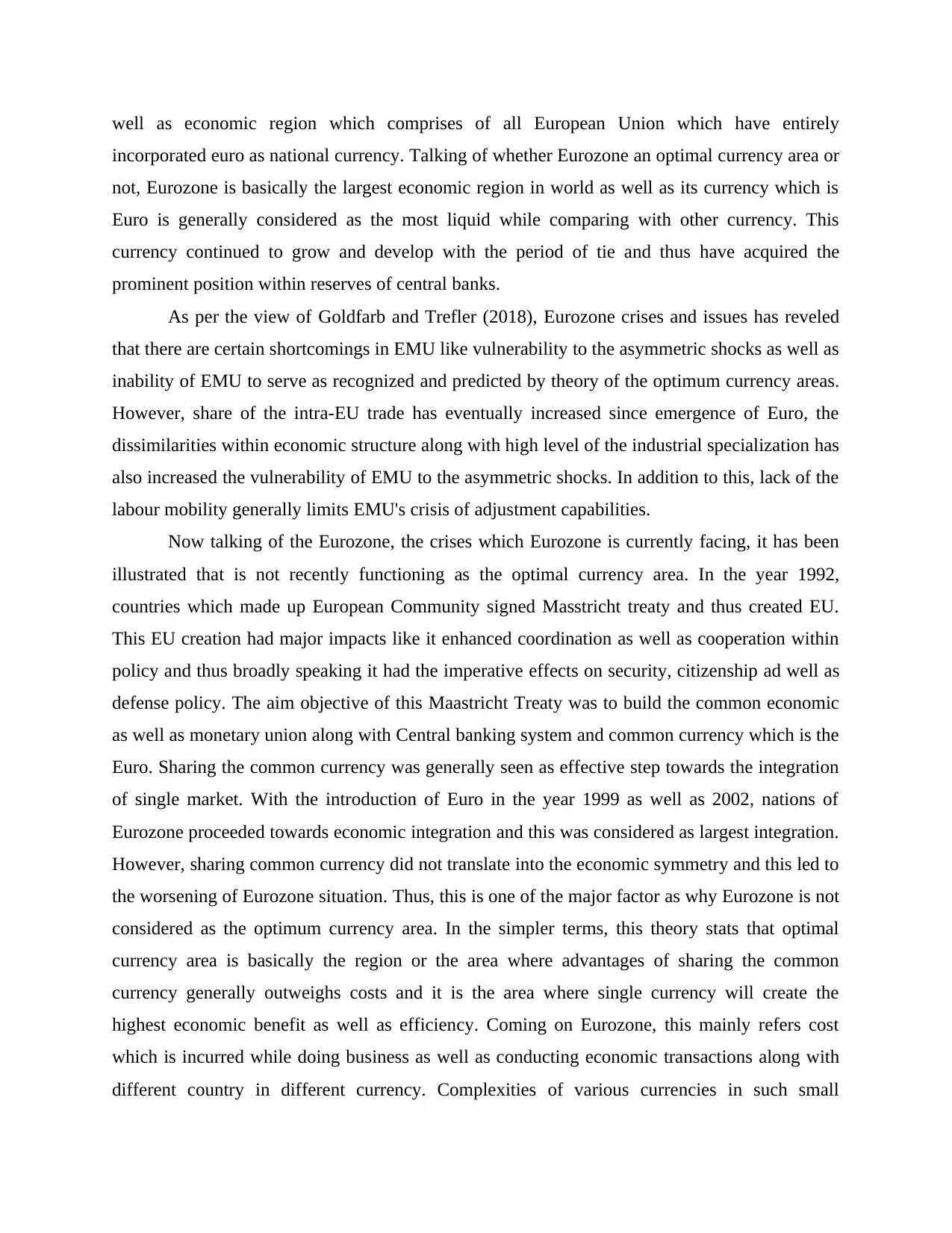
well as economic region which comprises of all European Union which have entirely
incorporated euro as national currency. Talking of whether Eurozone an optimal currency area or
not, Eurozone is basically the largest economic region in world as well as its currency which is
Euro is generally considered as the most liquid while comparing with other currency. This
currency continued to grow and develop with the period of tie and thus have acquired the
prominent position within reserves of central banks.
As per the view of Goldfarb and Trefler (2018), Eurozone crises and issues has reveled
that there are certain shortcomings in EMU like vulnerability to the asymmetric shocks as well as
inability of EMU to serve as recognized and predicted by theory of the optimum currency areas.
However, share of the intra-EU trade has eventually increased since emergence of Euro, the
dissimilarities within economic structure along with high level of the industrial specialization has
also increased the vulnerability of EMU to the asymmetric shocks. In addition to this, lack of the
labour mobility generally limits EMU's crisis of adjustment capabilities.
Now talking of the Eurozone, the crises which Eurozone is currently facing, it has been
illustrated that is not recently functioning as the optimal currency area. In the year 1992,
countries which made up European Community signed Masstricht treaty and thus created EU.
This EU creation had major impacts like it enhanced coordination as well as cooperation within
policy and thus broadly speaking it had the imperative effects on security, citizenship ad well as
defense policy. The aim objective of this Maastricht Treaty was to build the common economic
as well as monetary union along with Central banking system and common currency which is the
Euro. Sharing the common currency was generally seen as effective step towards the integration
of single market. With the introduction of Euro in the year 1999 as well as 2002, nations of
Eurozone proceeded towards economic integration and this was considered as largest integration.
However, sharing common currency did not translate into the economic symmetry and this led to
the worsening of Eurozone situation. Thus, this is one of the major factor as why Eurozone is not
considered as the optimum currency area. In the simpler terms, this theory stats that optimal
currency area is basically the region or the area where advantages of sharing the common
currency generally outweighs costs and it is the area where single currency will create the
highest economic benefit as well as efficiency. Coming on Eurozone, this mainly refers cost
which is incurred while doing business as well as conducting economic transactions along with
different country in different currency. Complexities of various currencies in such small
incorporated euro as national currency. Talking of whether Eurozone an optimal currency area or
not, Eurozone is basically the largest economic region in world as well as its currency which is
Euro is generally considered as the most liquid while comparing with other currency. This
currency continued to grow and develop with the period of tie and thus have acquired the
prominent position within reserves of central banks.
As per the view of Goldfarb and Trefler (2018), Eurozone crises and issues has reveled
that there are certain shortcomings in EMU like vulnerability to the asymmetric shocks as well as
inability of EMU to serve as recognized and predicted by theory of the optimum currency areas.
However, share of the intra-EU trade has eventually increased since emergence of Euro, the
dissimilarities within economic structure along with high level of the industrial specialization has
also increased the vulnerability of EMU to the asymmetric shocks. In addition to this, lack of the
labour mobility generally limits EMU's crisis of adjustment capabilities.
Now talking of the Eurozone, the crises which Eurozone is currently facing, it has been
illustrated that is not recently functioning as the optimal currency area. In the year 1992,
countries which made up European Community signed Masstricht treaty and thus created EU.
This EU creation had major impacts like it enhanced coordination as well as cooperation within
policy and thus broadly speaking it had the imperative effects on security, citizenship ad well as
defense policy. The aim objective of this Maastricht Treaty was to build the common economic
as well as monetary union along with Central banking system and common currency which is the
Euro. Sharing the common currency was generally seen as effective step towards the integration
of single market. With the introduction of Euro in the year 1999 as well as 2002, nations of
Eurozone proceeded towards economic integration and this was considered as largest integration.
However, sharing common currency did not translate into the economic symmetry and this led to
the worsening of Eurozone situation. Thus, this is one of the major factor as why Eurozone is not
considered as the optimum currency area. In the simpler terms, this theory stats that optimal
currency area is basically the region or the area where advantages of sharing the common
currency generally outweighs costs and it is the area where single currency will create the
highest economic benefit as well as efficiency. Coming on Eurozone, this mainly refers cost
which is incurred while doing business as well as conducting economic transactions along with
different country in different currency. Complexities of various currencies in such small
⊘ This is a preview!⊘
Do you want full access?
Subscribe today to unlock all pages.

Trusted by 1+ million students worldwide
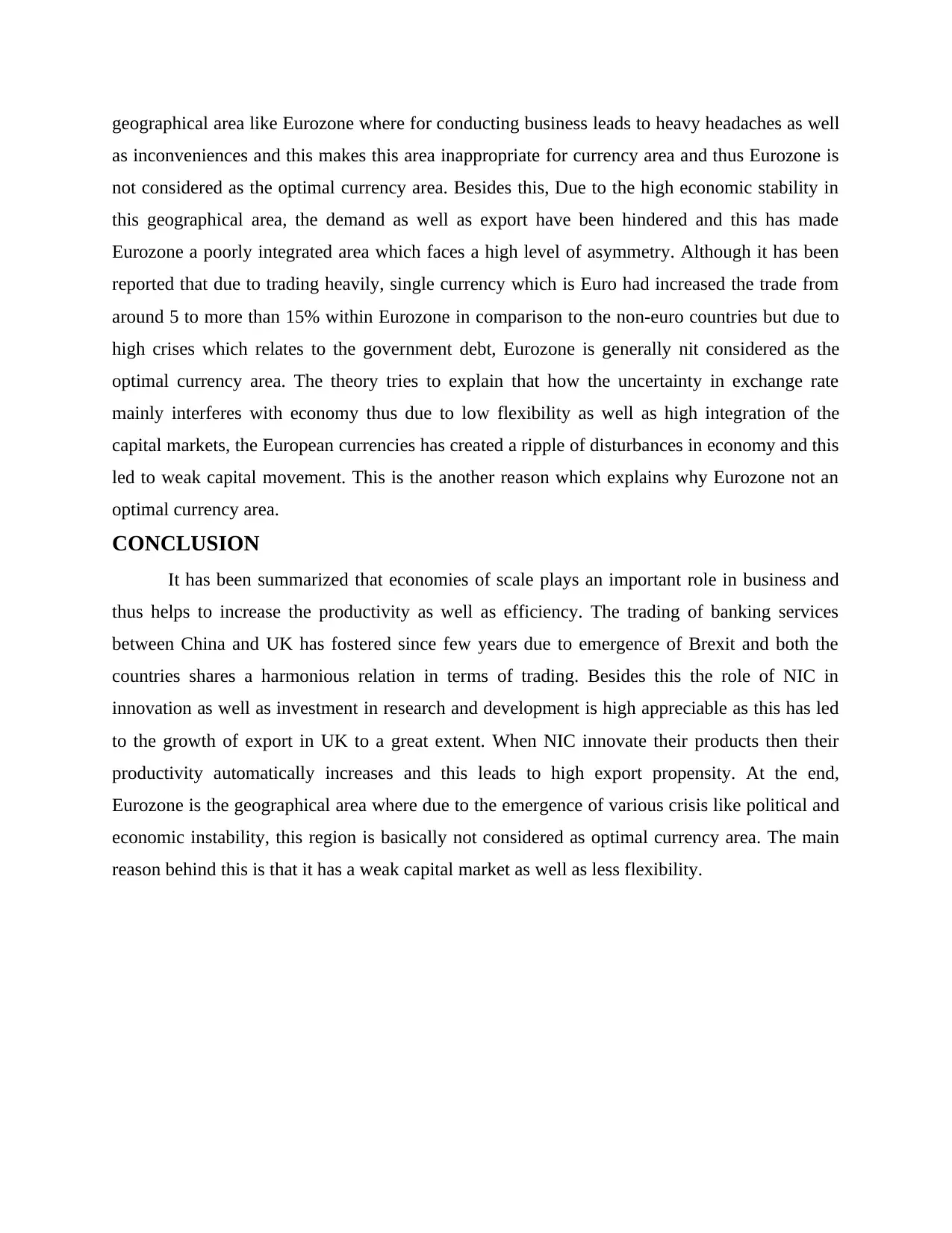
geographical area like Eurozone where for conducting business leads to heavy headaches as well
as inconveniences and this makes this area inappropriate for currency area and thus Eurozone is
not considered as the optimal currency area. Besides this, Due to the high economic stability in
this geographical area, the demand as well as export have been hindered and this has made
Eurozone a poorly integrated area which faces a high level of asymmetry. Although it has been
reported that due to trading heavily, single currency which is Euro had increased the trade from
around 5 to more than 15% within Eurozone in comparison to the non-euro countries but due to
high crises which relates to the government debt, Eurozone is generally nit considered as the
optimal currency area. The theory tries to explain that how the uncertainty in exchange rate
mainly interferes with economy thus due to low flexibility as well as high integration of the
capital markets, the European currencies has created a ripple of disturbances in economy and this
led to weak capital movement. This is the another reason which explains why Eurozone not an
optimal currency area.
CONCLUSION
It has been summarized that economies of scale plays an important role in business and
thus helps to increase the productivity as well as efficiency. The trading of banking services
between China and UK has fostered since few years due to emergence of Brexit and both the
countries shares a harmonious relation in terms of trading. Besides this the role of NIC in
innovation as well as investment in research and development is high appreciable as this has led
to the growth of export in UK to a great extent. When NIC innovate their products then their
productivity automatically increases and this leads to high export propensity. At the end,
Eurozone is the geographical area where due to the emergence of various crisis like political and
economic instability, this region is basically not considered as optimal currency area. The main
reason behind this is that it has a weak capital market as well as less flexibility.
as inconveniences and this makes this area inappropriate for currency area and thus Eurozone is
not considered as the optimal currency area. Besides this, Due to the high economic stability in
this geographical area, the demand as well as export have been hindered and this has made
Eurozone a poorly integrated area which faces a high level of asymmetry. Although it has been
reported that due to trading heavily, single currency which is Euro had increased the trade from
around 5 to more than 15% within Eurozone in comparison to the non-euro countries but due to
high crises which relates to the government debt, Eurozone is generally nit considered as the
optimal currency area. The theory tries to explain that how the uncertainty in exchange rate
mainly interferes with economy thus due to low flexibility as well as high integration of the
capital markets, the European currencies has created a ripple of disturbances in economy and this
led to weak capital movement. This is the another reason which explains why Eurozone not an
optimal currency area.
CONCLUSION
It has been summarized that economies of scale plays an important role in business and
thus helps to increase the productivity as well as efficiency. The trading of banking services
between China and UK has fostered since few years due to emergence of Brexit and both the
countries shares a harmonious relation in terms of trading. Besides this the role of NIC in
innovation as well as investment in research and development is high appreciable as this has led
to the growth of export in UK to a great extent. When NIC innovate their products then their
productivity automatically increases and this leads to high export propensity. At the end,
Eurozone is the geographical area where due to the emergence of various crisis like political and
economic instability, this region is basically not considered as optimal currency area. The main
reason behind this is that it has a weak capital market as well as less flexibility.
Paraphrase This Document
Need a fresh take? Get an instant paraphrase of this document with our AI Paraphraser
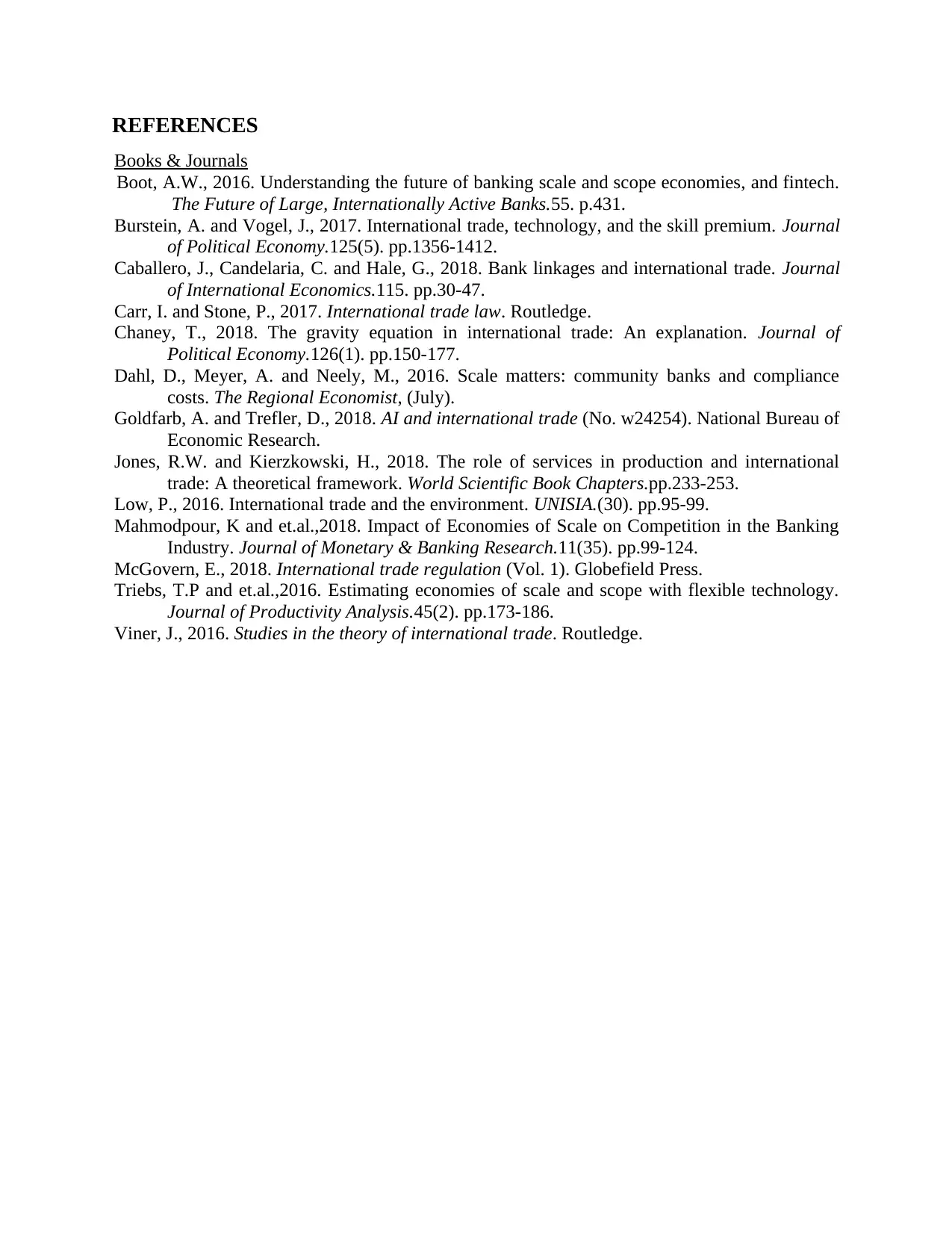
REFERENCES
Books & Journals
Boot, A.W., 2016. Understanding the future of banking scale and scope economies, and fintech.
The Future of Large, Internationally Active Banks.55. p.431.
Burstein, A. and Vogel, J., 2017. International trade, technology, and the skill premium. Journal
of Political Economy.125(5). pp.1356-1412.
Caballero, J., Candelaria, C. and Hale, G., 2018. Bank linkages and international trade. Journal
of International Economics.115. pp.30-47.
Carr, I. and Stone, P., 2017. International trade law. Routledge.
Chaney, T., 2018. The gravity equation in international trade: An explanation. Journal of
Political Economy.126(1). pp.150-177.
Dahl, D., Meyer, A. and Neely, M., 2016. Scale matters: community banks and compliance
costs. The Regional Economist, (July).
Goldfarb, A. and Trefler, D., 2018. AI and international trade (No. w24254). National Bureau of
Economic Research.
Jones, R.W. and Kierzkowski, H., 2018. The role of services in production and international
trade: A theoretical framework. World Scientific Book Chapters.pp.233-253.
Low, P., 2016. International trade and the environment. UNISIA.(30). pp.95-99.
Mahmodpour, K and et.al.,2018. Impact of Economies of Scale on Competition in the Banking
Industry. Journal of Monetary & Banking Research.11(35). pp.99-124.
McGovern, E., 2018. International trade regulation (Vol. 1). Globefield Press.
Triebs, T.P and et.al.,2016. Estimating economies of scale and scope with flexible technology.
Journal of Productivity Analysis.45(2). pp.173-186.
Viner, J., 2016. Studies in the theory of international trade. Routledge.
Books & Journals
Boot, A.W., 2016. Understanding the future of banking scale and scope economies, and fintech.
The Future of Large, Internationally Active Banks.55. p.431.
Burstein, A. and Vogel, J., 2017. International trade, technology, and the skill premium. Journal
of Political Economy.125(5). pp.1356-1412.
Caballero, J., Candelaria, C. and Hale, G., 2018. Bank linkages and international trade. Journal
of International Economics.115. pp.30-47.
Carr, I. and Stone, P., 2017. International trade law. Routledge.
Chaney, T., 2018. The gravity equation in international trade: An explanation. Journal of
Political Economy.126(1). pp.150-177.
Dahl, D., Meyer, A. and Neely, M., 2016. Scale matters: community banks and compliance
costs. The Regional Economist, (July).
Goldfarb, A. and Trefler, D., 2018. AI and international trade (No. w24254). National Bureau of
Economic Research.
Jones, R.W. and Kierzkowski, H., 2018. The role of services in production and international
trade: A theoretical framework. World Scientific Book Chapters.pp.233-253.
Low, P., 2016. International trade and the environment. UNISIA.(30). pp.95-99.
Mahmodpour, K and et.al.,2018. Impact of Economies of Scale on Competition in the Banking
Industry. Journal of Monetary & Banking Research.11(35). pp.99-124.
McGovern, E., 2018. International trade regulation (Vol. 1). Globefield Press.
Triebs, T.P and et.al.,2016. Estimating economies of scale and scope with flexible technology.
Journal of Productivity Analysis.45(2). pp.173-186.
Viner, J., 2016. Studies in the theory of international trade. Routledge.

⊘ This is a preview!⊘
Do you want full access?
Subscribe today to unlock all pages.

Trusted by 1+ million students worldwide
1 out of 12
Related Documents
Your All-in-One AI-Powered Toolkit for Academic Success.
+13062052269
info@desklib.com
Available 24*7 on WhatsApp / Email
![[object Object]](/_next/static/media/star-bottom.7253800d.svg)
Unlock your academic potential
Copyright © 2020–2025 A2Z Services. All Rights Reserved. Developed and managed by ZUCOL.




